Analyzing enhancement and control of kerrnonlinear coefficient in a three - level v - type inhomogeneously broadened atomic medium
The analytical expression for the self-Kerr nonlinear coefficient in a three-level V-type
atomic medium is found in the presence of the Doppler effect. Based on the analytical results,
we have analyzed the enhancement and control of the Kerr nonlinear coefficient under the
condition of electromagnetically induced transparency. It is shown that the Kerr nonlinear
coefficient is significantly enhanced around the resonant frequency of both the probe and
coupling fields. Simultaneously, the magnitude and sign of the Kerr nonlinear coefficient are
controlled with respect to the intensity and frequency of the coupling laser field. The
amplitude of the Kerr nonlinear coefficient decreases remarkably as temperature increases
(i.e., the Doppler width increases). The analytical model can find potential applications in
photonic devices and can explain experimental observations of the Kerr nonlinear coefficient
at different temperatures.
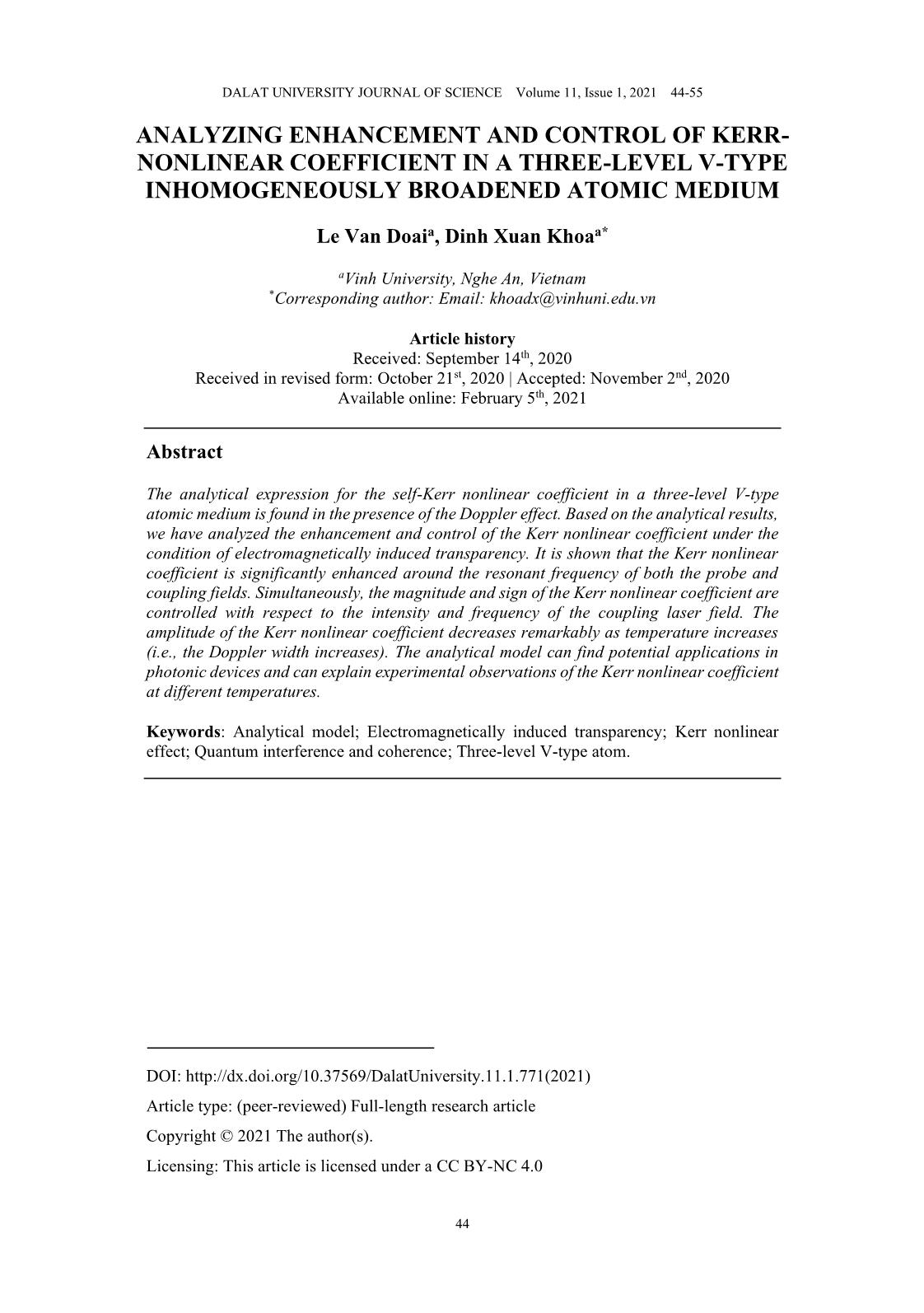
Trang 1
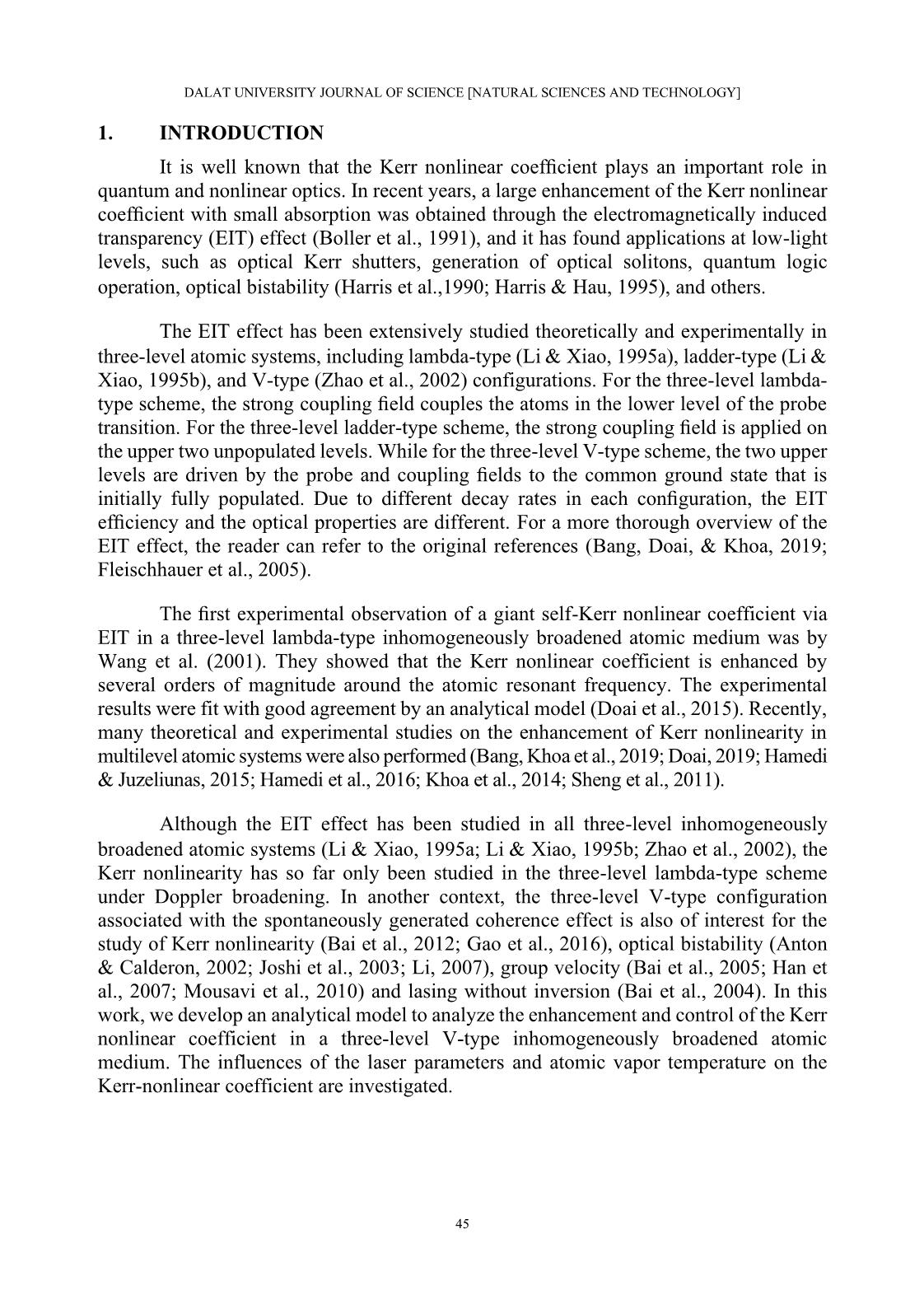
Trang 2
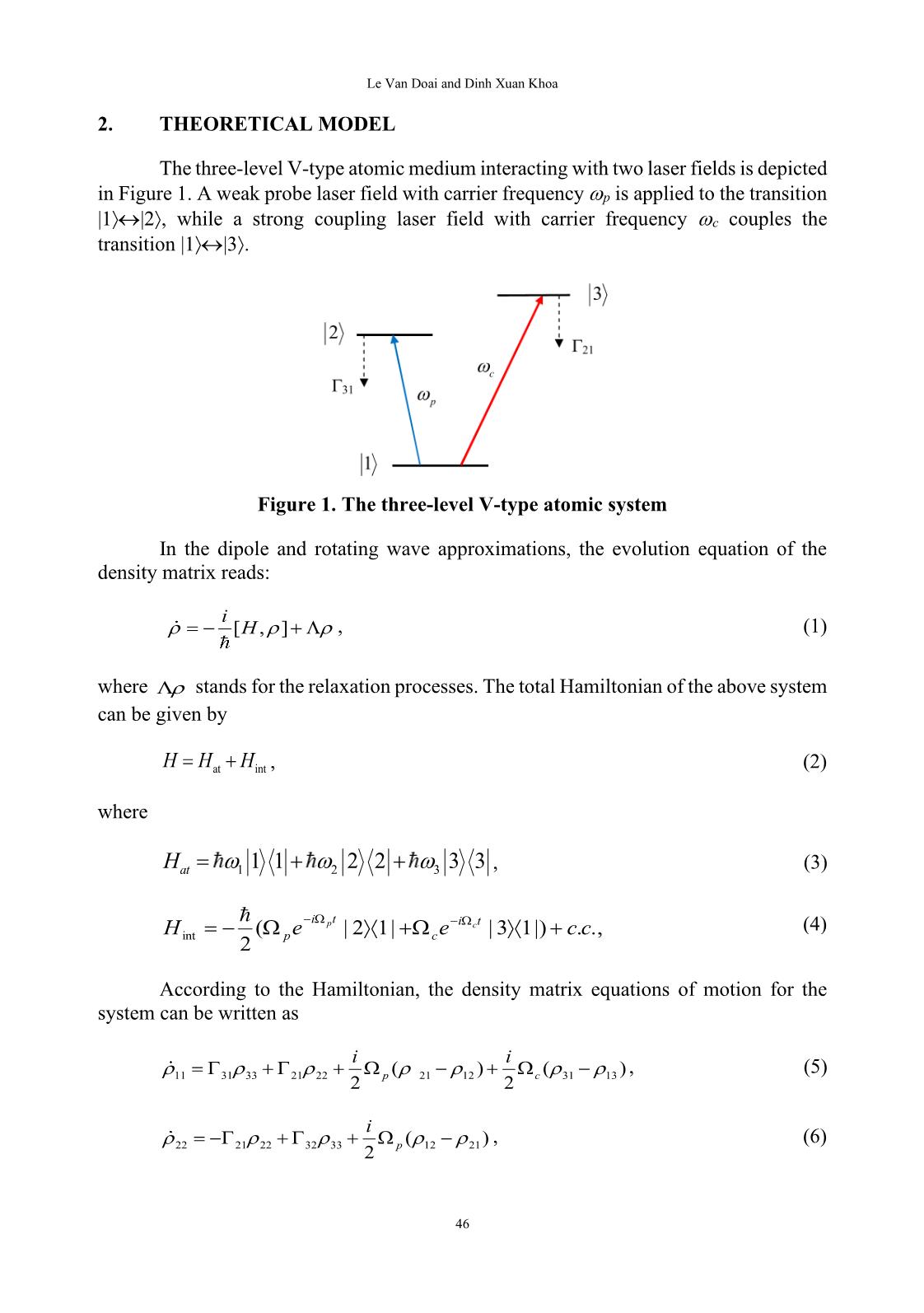
Trang 3
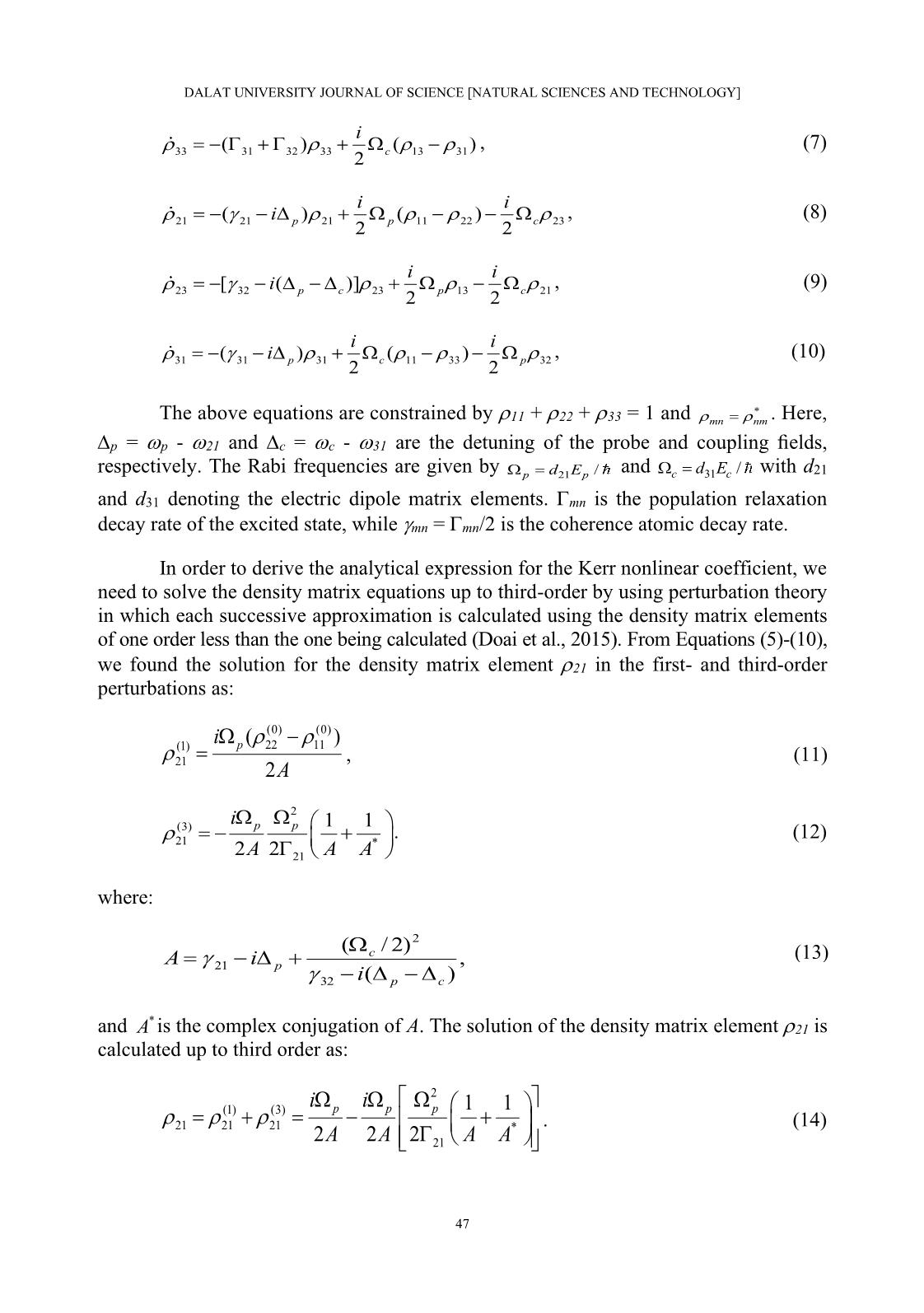
Trang 4
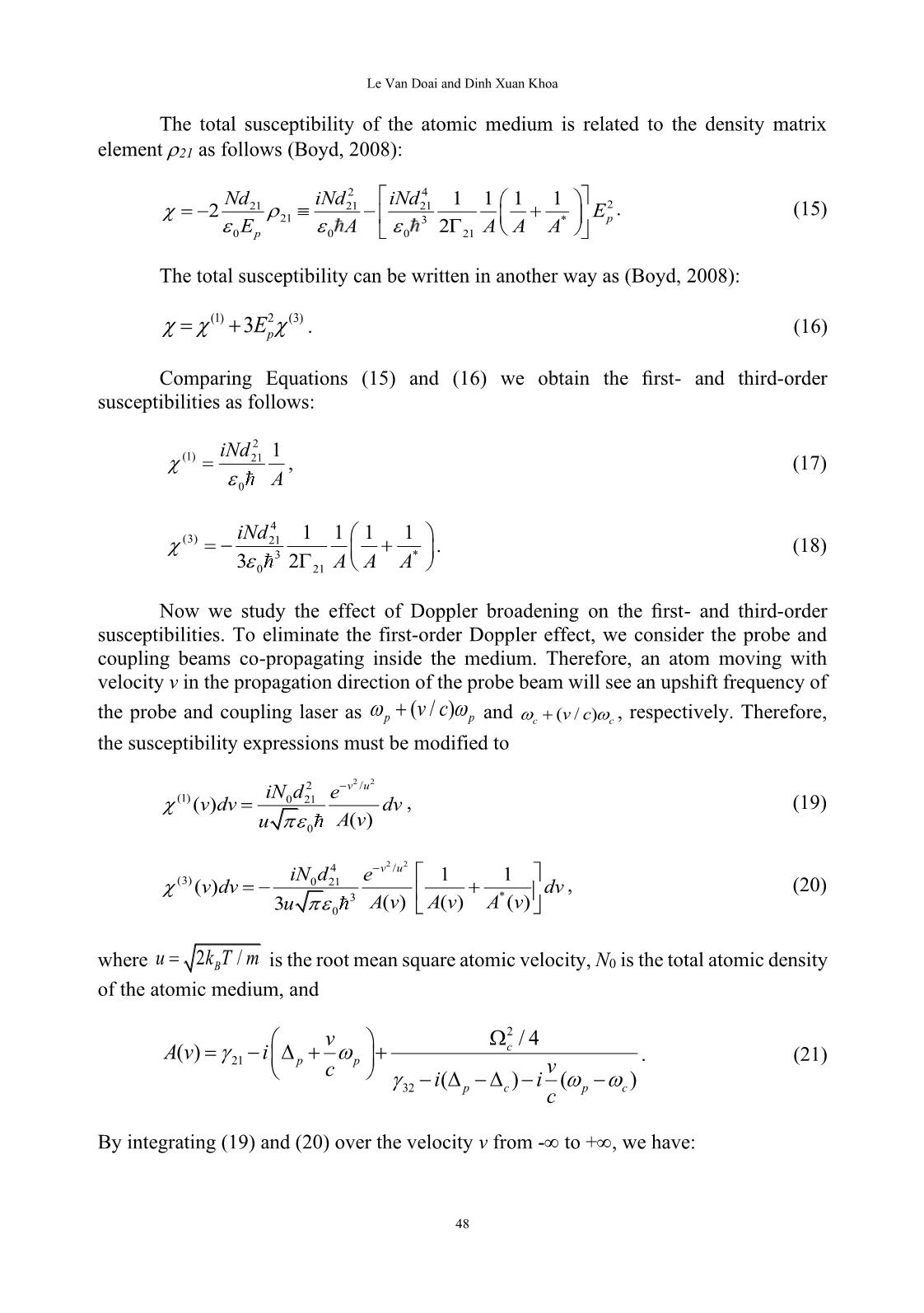
Trang 5
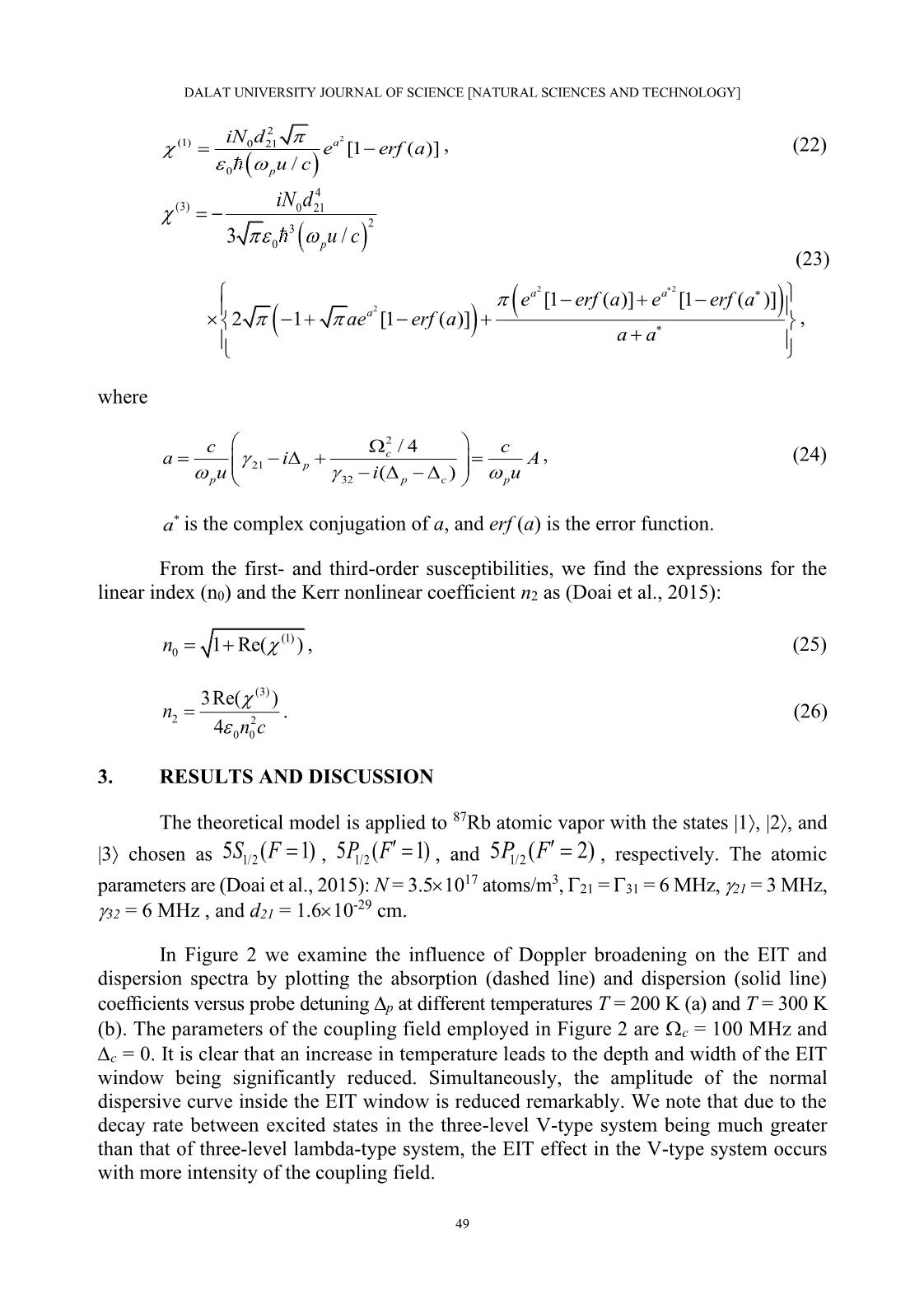
Trang 6
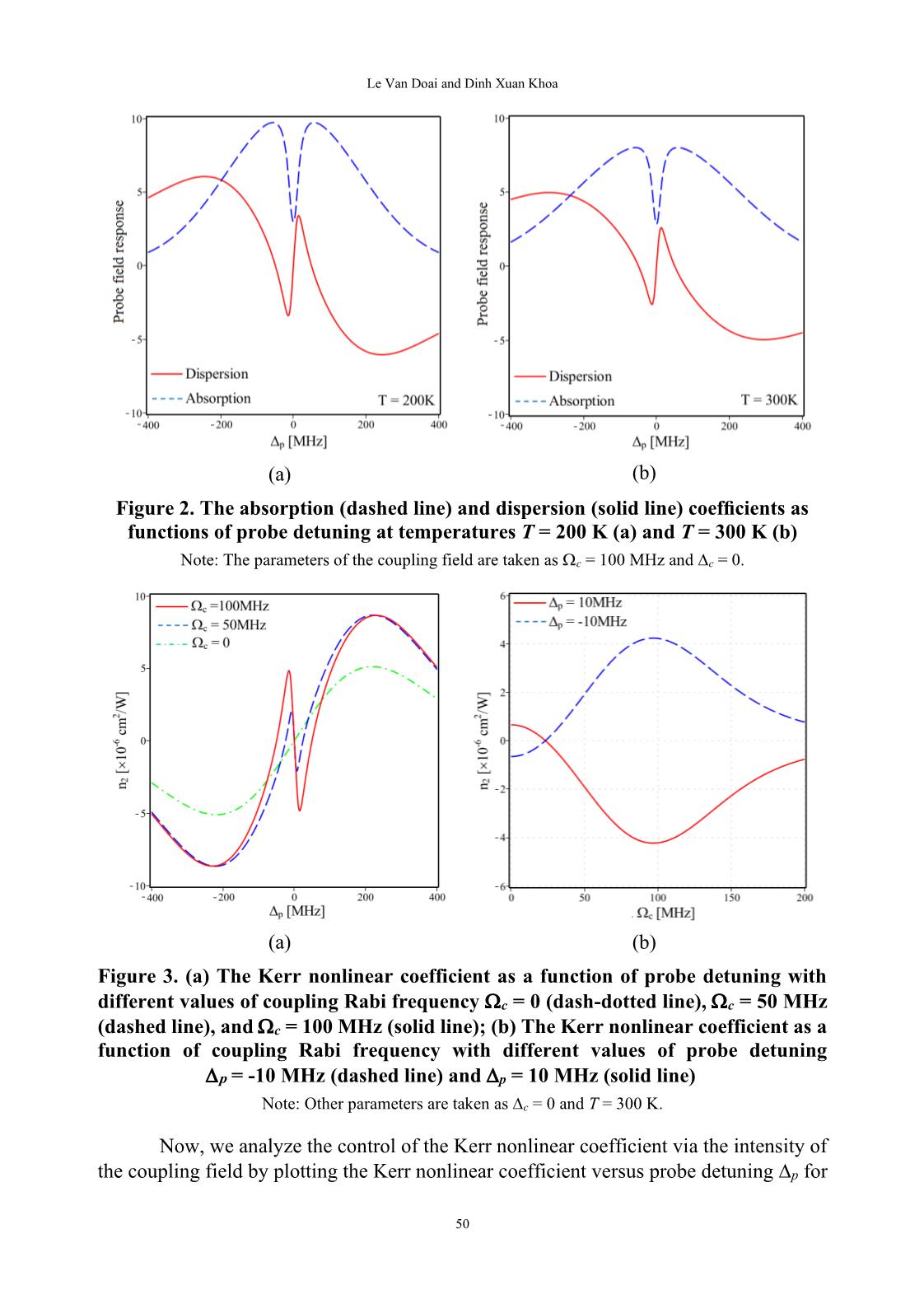
Trang 7
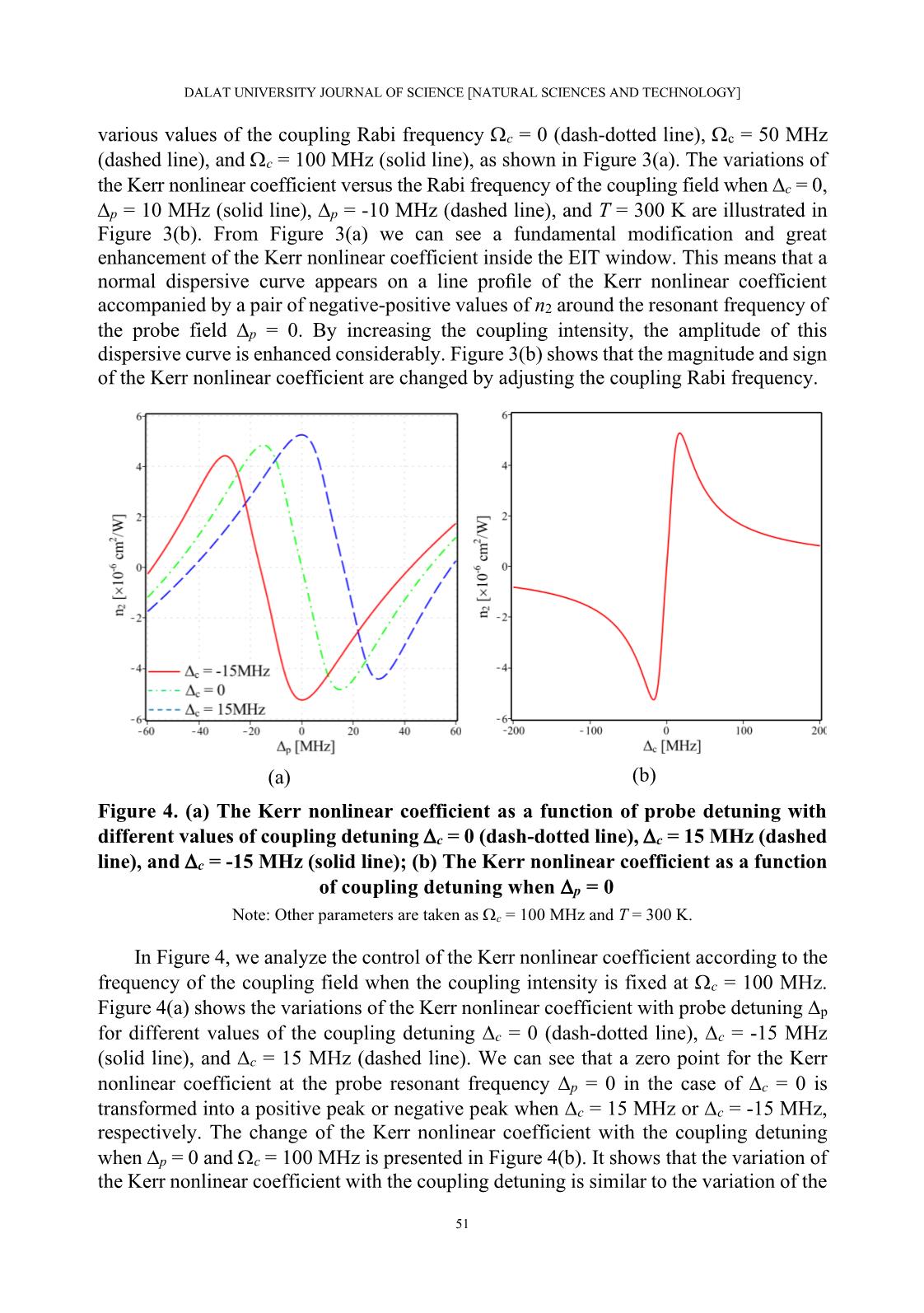
Trang 8
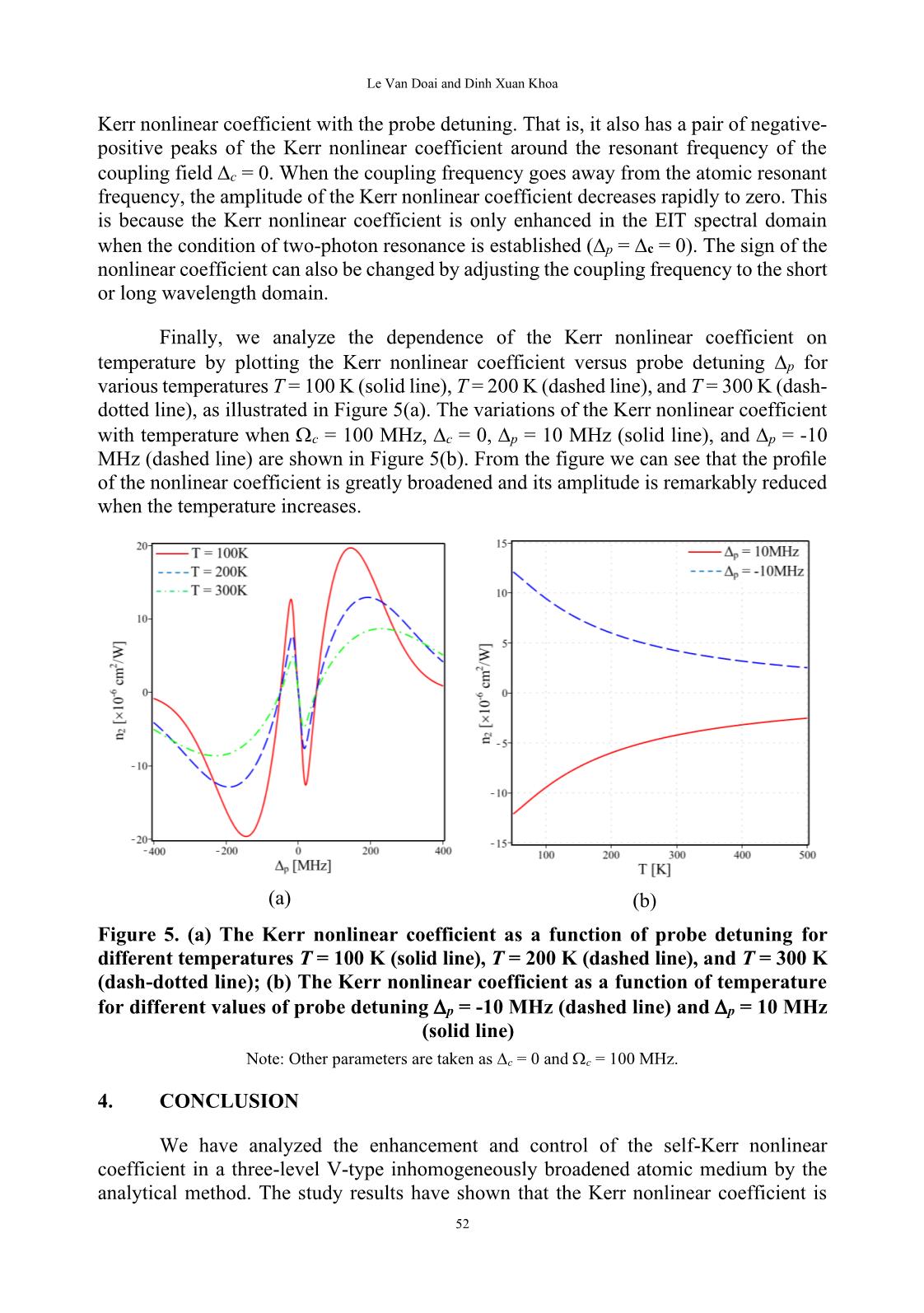
Trang 9
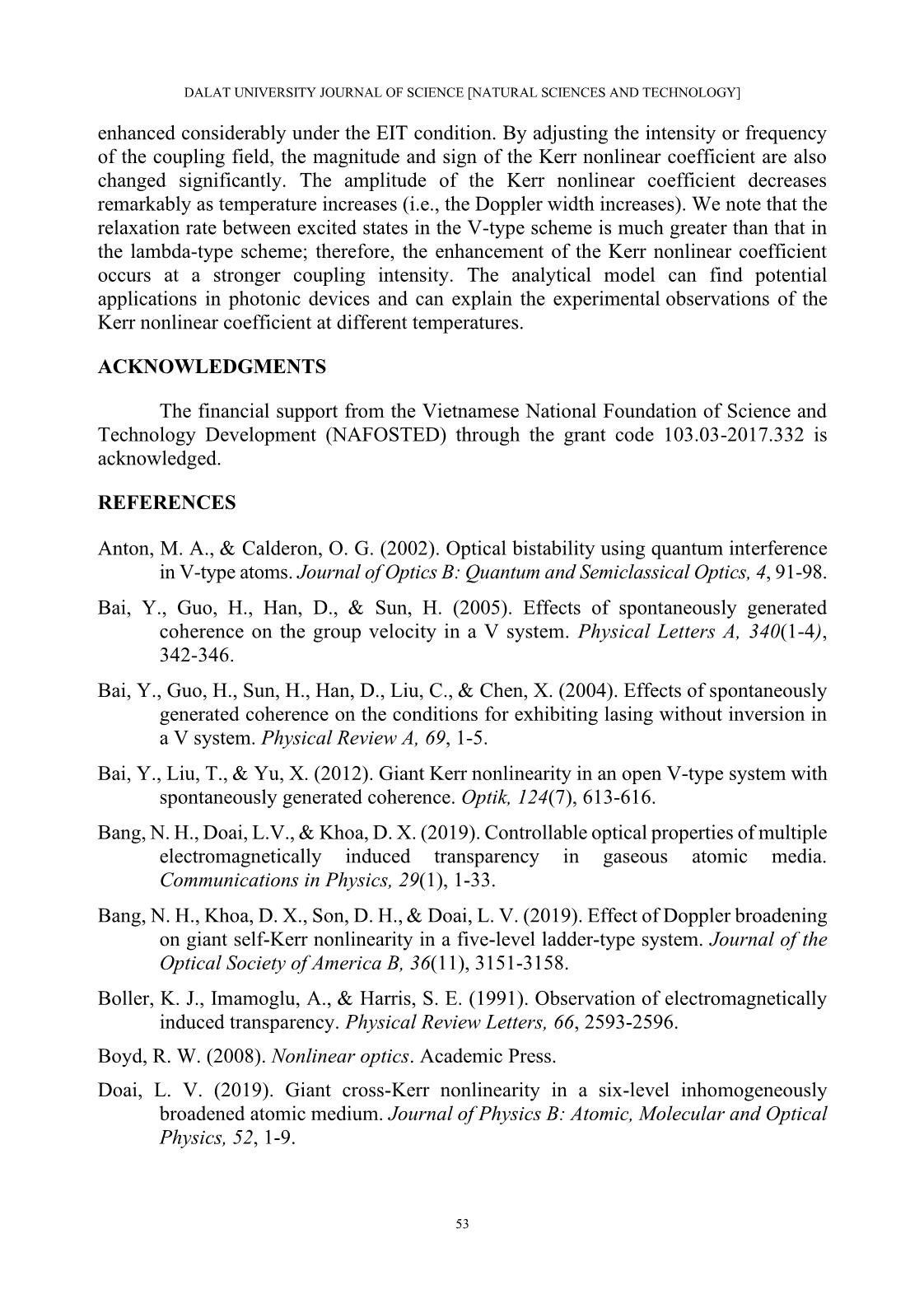
Trang 10
Tải về để xem bản đầy đủ
Tóm tắt nội dung tài liệu: Analyzing enhancement and control of kerrnonlinear coefficient in a three - level v - type inhomogeneously broadened atomic medium
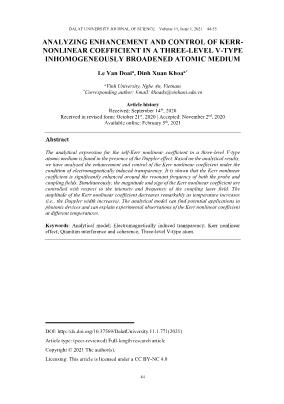
1) 21 ( ) 2 pi A − = , (11) 2 (3) 21 * 21 1 1 2 2 p pi A A A = − + . (12) where: , )( )2/( 32 2 21 cp c p i iA − − + −= and *A is the complex conjugation of A. The solution of the density matrix element 21 is calculated up to third order as: 2 (1) (3) 21 21 21 * 21 1 1 2 2 2 p p pi i A A A A = + = − + . (14) (13) Le Van Doai and Dinh Xuan Khoa 48 The total susceptibility of the atomic medium is related to the density matrix element 21 as follows (Boyd, 2008): 2 4 221 21 21 21 3 * 0 0 0 21 1 1 1 1 2 2 p p Nd iNd iNd E E A A A A = − − + . (15) The total susceptibility can be written in another way as (Boyd, 2008): (1) 2 (3)3 pE = + . (16) Comparing Equations (15) and (16) we obtain the first- and third-order susceptibilities as follows: 2 (1) 21 0 1iNd A = , (17) 4 (3) 21 3 * 0 21 1 1 1 1 3 2 iNd A A A = − + . (18) Now we study the effect of Doppler broadening on the first- and third-order susceptibilities. To eliminate the first-order Doppler effect, we consider the probe and coupling beams co-propagating inside the medium. Therefore, an atom moving with velocity v in the propagation direction of the probe beam will see an upshift frequency of the probe and coupling laser as ( / )p pv c + and ( / )c cv c + , respectively. Therefore, the susceptibility expressions must be modified to 2 22 / (1) 0 21 0 ( ) ( ) v uiN d e v dv dv A vu − = , (19) 2 24 / (3) 0 21 *3 0 1 1 ( ) ( ) ( ) ( )3 v uiN d e v dv dv A v A v A vu − = − + , (20) where 2 /Bu k T m= is the root mean square atomic velocity, N0 is the total atomic density of the atomic medium, and 2 21 32 / 4 ( ) ( ) ( ) c p p p c p c v A v i vc i i c = − + + − − − − . (21) By integrating (19) and (20) over the velocity v from - to + , we have: DALAT UNIVERSITY JOURNAL OF SCIENCE [NATURAL SCIENCES AND TECHNOLOGY] 49 ( ) 2 2 (1) 0 21 0 [1 ( )] / a p iN d e erf a u c = − , (22) ( ) 4 (3) 0 21 2 3 03 /p iN d u c = − ( ) ( ) 2 2 2 [1 ( )] [1 ( )] 2 1 [1 ( )] a a a e erf a e erf a ae erf a a a − + − − + − + + , where 2 21 32 / 4 ( ) c p p p c p c c a i A u i u = − + = − − , (24) *a is the complex conjugation of a, and erf (a) is the error function. From the first- and third-order susceptibilities, we find the expressions for the linear index (n0) and the Kerr nonlinear coefficient n2 as (Doai et al., 2015): (1) 0 1 Re( )n = + , (25) (3) 2 2 0 0 3Re( ) 4 n n c = . (26) 3. RESULTS AND DISCUSSION The theoretical model is applied to 87Rb atomic vapor with the states |1, |2, and |3 chosen as 1/25 ( 1)S F = , 1/25 ( 1)P F = , and 1/25 ( 2)P F = , respectively. The atomic parameters are (Doai et al., 2015): N = 3.5 1017 atoms/m3, 21 = 31 = 6 MHz, 21 = 3 MHz, 32 = 6 MHz , and d21 = 1.6 10-29 cm. In Figure 2 we examine the influence of Doppler broadening on the EIT and dispersion spectra by plotting the absorption (dashed line) and dispersion (solid line) coefficients versus probe detuning p at different temperatures T = 200 K (a) and T = 300 K (b). The parameters of the coupling field employed in Figure 2 are c = 100 MHz and c = 0. It is clear that an increase in temperature leads to the depth and width of the EIT window being significantly reduced. Simultaneously, the amplitude of the normal dispersive curve inside the EIT window is reduced remarkably. We note that due to the decay rate between excited states in the three-level V-type system being much greater than that of three-level lambda-type system, the EIT effect in the V-type system occurs with more intensity of the coupling field. ( (23) Le Van Doai and Dinh Xuan Khoa 50 (a) (b) Figure 2. The absorption (dashed line) and dispersion (solid line) coefficients as functions of probe detuning at temperatures T = 200 K (a) and T = 300 K (b) Note: The parameters of the coupling field are taken as c = 100 MHz and c = 0. (a) (b) Figure 3. (a) The Kerr nonlinear coefficient as a function of probe detuning with different values of coupling Rabi frequency c = 0 (dash-dotted line), c = 50 MHz (dashed line), and c = 100 MHz (solid line); (b) The Kerr nonlinear coefficient as a function of coupling Rabi frequency with different values of probe detuning p = -10 MHz (dashed line) and p = 10 MHz (solid line) Note: Other parameters are taken as c = 0 and T = 300 K. Now, we analyze the control of the Kerr nonlinear coefficient via the intensity of the coupling field by plotting the Kerr nonlinear coefficient versus probe detuning p for DALAT UNIVERSITY JOURNAL OF SCIENCE [NATURAL SCIENCES AND TECHNOLOGY] 51 various values of the coupling Rabi frequency c = 0 (dash-dotted line), c = 50 MHz (dashed line), and c = 100 MHz (solid line), as shown in Figure 3(a). The variations of the Kerr nonlinear coefficient versus the Rabi frequency of the coupling field when c = 0, p = 10 MHz (solid line), p = -10 MHz (dashed line), and T = 300 K are illustrated in Figure 3(b). From Figure 3(a) we can see a fundamental modification and great enhancement of the Kerr nonlinear coefficient inside the EIT window. This means that a normal dispersive curve appears on a line profile of the Kerr nonlinear coefficient accompanied by a pair of negative-positive values of n2 around the resonant frequency of the probe field p = 0. By increasing the coupling intensity, the amplitude of this dispersive curve is enhanced considerably. Figure 3(b) shows that the magnitude and sign of the Kerr nonlinear coefficient are changed by adjusting the coupling Rabi frequency. (a) (b) Figure 4. (a) The Kerr nonlinear coefficient as a function of probe detuning with different values of coupling detuning c = 0 (dash-dotted line), c = 15 MHz (dashed line), and c = -15 MHz (solid line); (b) The Kerr nonlinear coefficient as a function of coupling detuning when p = 0 Note: Other parameters are taken as c = 100 MHz and T = 300 K. In Figure 4, we analyze the control of the Kerr nonlinear coefficient according to the frequency of the coupling field when the coupling intensity is fixed at c = 100 MHz. Figure 4(a) shows the variations of the Kerr nonlinear coefficient with probe detuning p for different values of the coupling detuning c = 0 (dash-dotted line), c = -15 MHz (solid line), and c = 15 MHz (dashed line). We can see that a zero point for the Kerr nonlinear coefficient at the probe resonant frequency p = 0 in the case of c = 0 is transformed into a positive peak or negative peak when c = 15 MHz or c = -15 MHz, respectively. The change of the Kerr nonlinear coefficient with the coupling detuning when p = 0 and c = 100 MHz is presented in Figure 4(b). It shows that the variation of the Kerr nonlinear coefficient with the coupling detuning is similar to the variation of the Le Van Doai and Dinh Xuan Khoa 52 Kerr nonlinear coefficient with the probe detuning. That is, it also has a pair of negative- positive peaks of the Kerr nonlinear coefficient around the resonant frequency of the coupling field c = 0. When the coupling frequency goes away from the atomic resonant frequency, the amplitude of the Kerr nonlinear coefficient decreases rapidly to zero. This is because the Kerr nonlinear coefficient is only enhanced in the EIT spectral domain when the condition of two-photon resonance is established ( p = c = 0). The sign of the nonlinear coefficient can also be changed by adjusting the coupling frequency to the short or long wavelength domain. Finally, we analyze the dependence of the Kerr nonlinear coefficient on temperature by plotting the Kerr nonlinear coefficient versus probe detuning p for various temperatures T = 100 K (solid line), T = 200 K (dashed line), and T = 300 K (dash- dotted line), as illustrated in Figure 5(a). The variations of the Kerr nonlinear coefficient with temperature when c = 100 MHz, c = 0, p = 10 MHz (solid line), and p = -10 MHz (dashed line) are shown in Figure 5(b). From the figure we can see that the profile of the nonlinear coefficient is greatly broadened and its amplitude is remarkably reduced when the temperature increases. (a) (b) Figure 5. (a) The Kerr nonlinear coefficient as a function of probe detuning for different temperatures T = 100 K (solid line), T = 200 K (dashed line), and T = 300 K (dash-dotted line); (b) The Kerr nonlinear coefficient as a function of temperature for different values of probe detuning p = -10 MHz (dashed line) and p = 10 MHz (solid line) Note: Other parameters are taken as c = 0 and c = 100 MHz. 4. CONCLUSION We have analyzed the enhancement and control of the self-Kerr nonlinear coefficient in a three-level V-type inhomogeneously broadened atomic medium by the analytical method. The study results have shown that the Kerr nonlinear coefficient is DALAT UNIVERSITY JOURNAL OF SCIENCE [NATURAL SCIENCES AND TECHNOLOGY] 53 enhanced considerably under the EIT condition. By adjusting the intensity or frequency of the coupling field, the magnitude and sign of the Kerr nonlinear coefficient are also changed significantly. The amplitude of the Kerr nonlinear coefficient decreases remarkably as temperature increases (i.e., the Doppler width increases). We note that the relaxation rate between excited states in the V-type scheme is much greater than that in the lambda-type scheme; therefore, the enhancement of the Kerr nonlinear coefficient occurs at a stronger coupling intensity. The analytical model can find potential applications in photonic devices and can explain the experimental observations of the Kerr nonlinear coefficient at different temperatures. ACKNOWLEDGMENTS The financial support from the Vietnamese National Foundation of Science and Technology Development (NAFOSTED) through the grant code 103.03-2017.332 is acknowledged. REFERENCES Anton, M. A., Calderon, O. G. (2002). Optical bistability using quantum interference in V-type atoms. Journal of Optics B: Quantum and Semiclassical Optics, 4, 91-98. Bai, Y., Guo, H., Han, D., Sun, H. (2005). Effects of spontaneously generated coherence on the group velocity in a V system. Physical Letters A, 340(1-4), 342-346. Bai, Y., Guo, H., Sun, H., Han, D., Liu, C., Chen, X. (2004). Effects of spontaneously generated coherence on the conditions for exhibiting lasing without inversion in a V system. Physical Review A, 69, 1-5. Bai, Y., Liu, T., Yu, X. (2012). Giant Kerr nonlinearity in an open V-type system with spontaneously generated coherence. Optik, 124(7), 613-616. Bang, N. H., Doai, L.V., Khoa, D. X. (2019). Controllable optical properties of multiple electromagnetically induced transparency in gaseous atomic media. Communications in Physics, 29(1), 1-33. Bang, N. H., Khoa, D. X., Son, D. H., Doai, L. V. (2019). Effect of Doppler broadening on giant self-Kerr nonlinearity in a five-level ladder-type system. Journal of the Optical Society of America B, 36(11), 3151-3158. Boller, K. J., Imamoglu, A., Harris, S. E. (1991). Observation of electromagnetically induced transparency. Physical Review Letters, 66, 2593-2596. Boyd, R. W. (2008). Nonlinear optics. Academic Press. Doai, L. V. (2019). Giant cross-Kerr nonlinearity in a six-level inhomogeneously broadened atomic medium. Journal of Physics B: Atomic, Molecular and Optical Physics, 52, 1-9. Le Van Doai and Dinh Xuan Khoa 54 Doai, L. V., Khoa, D. X., Bang, N. H. (2015). EIT enhanced self-Kerr nonlinearity in the three-level lambda system under Doppler broadening. Physica Scripta, 90(4), 1-6. Fleischhauer, M., Imamoglu, I., Marangos, J. P. (2005). Electromagnetically induced transparency: Optics in coherent media. Reviews of Modern Physics, 77, 633-673. Gao, H., Sun, H., Fan, S., Zhang, H. (2016). Phase control of Kerr nonlinearity in V- type system with spontaneously generated coherence. Journal of Modern Optics, 63(6), 598-604. Hamedi, H. R., Gharamaleki, A. H., Sahrai, M. (2016). Colossal Kerr nonlinearity based on electromagnetically induced transparency in a five-level double-ladder atomic system. Applied Optics, 55(22), 5892-5899. Hamedi, H. R., Juzeliunas, G. (2015). Phase-sensitive Kerr nonlinearity for closed- loop quantum systems. Physical Review A, 91, 1-13. Han, D., Zeng, Y., Bai, Y., Chen, W., & Lu, H. (2007). Phase effects on group velocity propagation in a V-type system with spontaneously generated coherence. Journal of Modern Optics, 54, 493-500. Harris, S. E., Field, J. E., Imamoglu, A. (1990). Nonlinear optical processes using electromagnetically induced transparency. Physical Review Letters, 64, 1107-1110. Harris, S. E., Hau, L. V. (1995). Nonlinear optics at low light levels. Physical Review Letters, 82, 4611-4614. Joshi, A., Yang, W., Xiao, M. (2003). Effect of quantum interference on optical bistability in the three-level V-type atomic system. Physical Review A, 68, 1-4. Khoa, D. X., Doai, L. V., Son, D. H., Bang, N. H. (2014). Enhancement of self-Kerr nonlinearity via electromagnetically induced transparency in a five-level cascade system: An analytical approach. Journal of the Optical Society of America B, 31(6), 1330-1334. Li, J. (2007). Coherent control of optical bistability in a microwave-driven V-type atomic system. Physica D: Nonlinear Phenomena, 228(2), 148-152. Li, Y.-q., Xiao, M. (1995a). Electromagnetically induced transparency in a three-level Λ-type system in rubidium atoms. Physical Review A, 51(4), 2703-2706. Li, Y.-q., Xiao, M. (1995b). Electromagnetically induced transparency in ladder-type inhomogeneously broadened media: Theory and experiment. Physical Review A, 51(1), 576-584. Mousavi, S. M., Safari, L., Mahmoudi, M., Sahrai, M. (2010). Effect of quantum interference on the optical properties of a three-level V-type atomic system beyond the two-photon resonance condition. Journal of Physics B: Atomic, Molecular and Optical Physics, 43, 1-8. Sheng, J., Yang, X., Wu, H., Xiao, M. (2011). Modified self-Kerr-nonlinearity in a four-level N-type atomic system. Physical Review A, 84, 1-5. DALAT UNIVERSITY JOURNAL OF SCIENCE [NATURAL SCIENCES AND TECHNOLOGY] 55 Wang, H., Goorskey, D., Xiao, M. (2001). Enhanced Kerr nonlinearity via atomic coherence in a three-level atomic system. Physical Review Letters, 87(7), 1-4. Zhao, J., Wang, L., Xiao, L., Zhao, Y., Yin, W., Jia, S. (2002). Experimental measurement of absorption and dispersion in V-type cesium atom. Optics Communications, 206, 341-345.
File đính kèm:
 analyzing_enhancement_and_control_of_kerrnonlinear_coefficie.pdf
analyzing_enhancement_and_control_of_kerrnonlinear_coefficie.pdf

